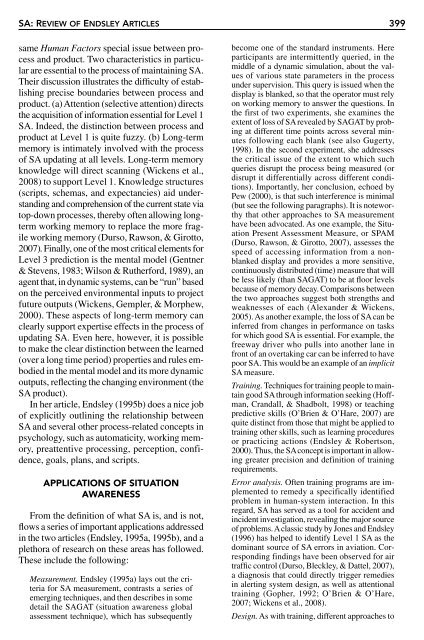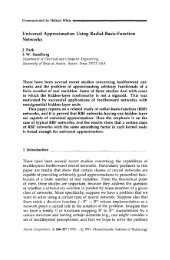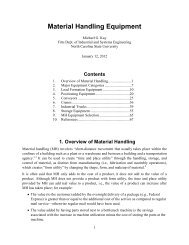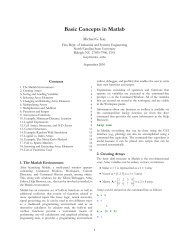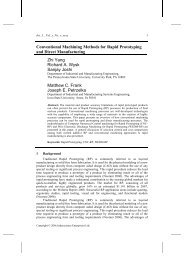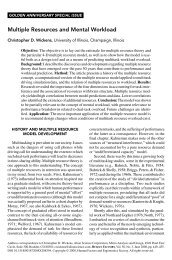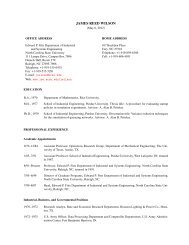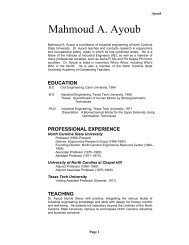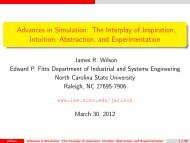Situation Awareness: Review of Mica Endsley's 1995 Articles on ...
Situation Awareness: Review of Mica Endsley's 1995 Articles on ...
Situation Awareness: Review of Mica Endsley's 1995 Articles on ...
You also want an ePaper? Increase the reach of your titles
YUMPU automatically turns print PDFs into web optimized ePapers that Google loves.
SA: REVIEW OF ENDSLEY ARTICLES 399<br />
same Human Factors special issue between process<br />
and product. Two characteristics in particular<br />
are essential to the process <str<strong>on</strong>g>of</str<strong>on</strong>g> maintaining SA.<br />
Their discussi<strong>on</strong> illustrates the difficulty <str<strong>on</strong>g>of</str<strong>on</strong>g> establishing<br />
precise boundaries between process and<br />
product. (a) Attenti<strong>on</strong> (selective attenti<strong>on</strong>) directs<br />
the acquisiti<strong>on</strong> <str<strong>on</strong>g>of</str<strong>on</strong>g> informati<strong>on</strong> essential for Level 1<br />
SA. Indeed, the distincti<strong>on</strong> between process and<br />
product at Level 1 is quite fuzzy. (b) L<strong>on</strong>g-term<br />
memory is intimately involved with the process<br />
<str<strong>on</strong>g>of</str<strong>on</strong>g> SA updating at all levels. L<strong>on</strong>g-term memory<br />
knowledge will direct scanning (Wickens et al.,<br />
2008) to support Level 1. Knowledge structures<br />
(scripts, schemas, and expectancies) aid understanding<br />
and comprehensi<strong>on</strong> <str<strong>on</strong>g>of</str<strong>on</strong>g> the current state via<br />
top-down processes, thereby <str<strong>on</strong>g>of</str<strong>on</strong>g>ten allowing l<strong>on</strong>gterm<br />
working memory to replace the more fragile<br />
working memory (Durso, Raws<strong>on</strong>, & Girotto,<br />
2007). Finally, <strong>on</strong>e <str<strong>on</strong>g>of</str<strong>on</strong>g> the most critical elements for<br />
Level 3 predicti<strong>on</strong> is the mental model (Gentner<br />
& Stevens, 1983; Wils<strong>on</strong> & Rutherford, 1989), an<br />
agent that, in dynamic systems, can be “run” based<br />
<strong>on</strong> the perceived envir<strong>on</strong>mental inputs to project<br />
future outputs (Wickens, Gempler, & Morphew,<br />
2000). These aspects <str<strong>on</strong>g>of</str<strong>on</strong>g> l<strong>on</strong>g-term memory can<br />
clearly support expertise effects in the process <str<strong>on</strong>g>of</str<strong>on</strong>g><br />
updating SA. Even here, however, it is possible<br />
to make the clear distincti<strong>on</strong> between the learned<br />
(over a l<strong>on</strong>g time period) properties and rules embodied<br />
in the mental model and its more dynamic<br />
outputs, reflecting the changing envir<strong>on</strong>ment (the<br />
SA product).<br />
In her article, Endsley (<str<strong>on</strong>g>1995</str<strong>on</strong>g>b) does a nice job<br />
<str<strong>on</strong>g>of</str<strong>on</strong>g> explicitly outlining the relati<strong>on</strong>ship between<br />
SA and several other process-related c<strong>on</strong>cepts in<br />
psychology, such as automaticity, working memory,<br />
preattentive processing, percepti<strong>on</strong>, c<strong>on</strong>fidence,<br />
goals, plans, and scripts.<br />
APPLICATIONS OF SITUATION<br />
AWARENESS<br />
From the definiti<strong>on</strong> <str<strong>on</strong>g>of</str<strong>on</strong>g> what SA is, and is not,<br />
flows a series <str<strong>on</strong>g>of</str<strong>on</strong>g> important applicati<strong>on</strong>s addressed<br />
in the two articles (Endsley, <str<strong>on</strong>g>1995</str<strong>on</strong>g>a, <str<strong>on</strong>g>1995</str<strong>on</strong>g>b), and a<br />
plethora <str<strong>on</strong>g>of</str<strong>on</strong>g> research <strong>on</strong> these areas has followed.<br />
These include the following:<br />
Measurement. Endsley (<str<strong>on</strong>g>1995</str<strong>on</strong>g>a) lays out the criteria<br />
for SA measurement, c<strong>on</strong>trasts a series <str<strong>on</strong>g>of</str<strong>on</strong>g><br />
emerging techniques, and then describes in some<br />
detail the SAGAT (situati<strong>on</strong> awareness global<br />
assessment technique), which has subsequently<br />
become <strong>on</strong>e <str<strong>on</strong>g>of</str<strong>on</strong>g> the standard instruments. Here<br />
participants are intermittently queried, in the<br />
middle <str<strong>on</strong>g>of</str<strong>on</strong>g> a dynamic simulati<strong>on</strong>, about the values<br />
<str<strong>on</strong>g>of</str<strong>on</strong>g> various state parameters in the process<br />
under supervisi<strong>on</strong>. This query is issued when the<br />
display is blanked, so that the operator must rely<br />
<strong>on</strong> working memory to answer the questi<strong>on</strong>s. In<br />
the first <str<strong>on</strong>g>of</str<strong>on</strong>g> two experiments, she examines the<br />
extent <str<strong>on</strong>g>of</str<strong>on</strong>g> loss <str<strong>on</strong>g>of</str<strong>on</strong>g> SArevealed by SAGAT by probing<br />
at different time points across several minutes<br />
following each blank (see also Gugerty,<br />
1998). In the sec<strong>on</strong>d experiment, she addresses<br />
the critical issue <str<strong>on</strong>g>of</str<strong>on</strong>g> the extent to which such<br />
queries disrupt the process being measured (or<br />
disrupt it differentially across different c<strong>on</strong>diti<strong>on</strong>s).<br />
Importantly, her c<strong>on</strong>clusi<strong>on</strong>, echoed by<br />
Pew (2000), is that such interference is minimal<br />
(but see the following paragraphs). It is noteworthy<br />
that other approaches to SA measurement<br />
have been advocated. As <strong>on</strong>e example, the <str<strong>on</strong>g>Situati<strong>on</strong></str<strong>on</strong>g><br />
Present Assessment Measure, or SPAM<br />
(Durso, Raws<strong>on</strong>, & Girotto, 2007), assesses the<br />
speed <str<strong>on</strong>g>of</str<strong>on</strong>g> accessing informati<strong>on</strong> from a n<strong>on</strong>blanked<br />
display and provides a more sensitive,<br />
c<strong>on</strong>tinuously distributed (time) measure that will<br />
be less likely (than SAGAT) to be at floor levels<br />
because <str<strong>on</strong>g>of</str<strong>on</strong>g> memory decay. Comparis<strong>on</strong>s between<br />
the two approaches suggest both strengths and<br />
weaknesses <str<strong>on</strong>g>of</str<strong>on</strong>g> each (Alexander & Wickens,<br />
2005). As another example, the loss <str<strong>on</strong>g>of</str<strong>on</strong>g> SA can be<br />
inferred from changes in performance <strong>on</strong> tasks<br />
for which good SA is essential. For example, the<br />
freeway driver who pulls into another lane in<br />
fr<strong>on</strong>t <str<strong>on</strong>g>of</str<strong>on</strong>g> an overtaking car can be inferred to have<br />
poor SA. This would be an example <str<strong>on</strong>g>of</str<strong>on</strong>g> an implicit<br />
SA measure.<br />
Training. Techniques for training people to maintain<br />
good SAthrough informati<strong>on</strong> seeking (H<str<strong>on</strong>g>of</str<strong>on</strong>g>fman,<br />
Crandall, & Shadbolt, 1998) or teaching<br />
predictive skills (O’Brien & O’Hare, 2007) are<br />
quite distinct from those that might be applied to<br />
training other skills, such as learning procedures<br />
or practicing acti<strong>on</strong>s (Endsley & Roberts<strong>on</strong>,<br />
2000). Thus, the SAc<strong>on</strong>cept is important in allowing<br />
greater precisi<strong>on</strong> and definiti<strong>on</strong> <str<strong>on</strong>g>of</str<strong>on</strong>g> training<br />
requirements.<br />
Error analysis. Often training programs are implemented<br />
to remedy a specifically identified<br />
problem in human-system interacti<strong>on</strong>. In this<br />
regard, SA has served as a tool for accident and<br />
incident investigati<strong>on</strong>, revealing the major source<br />
<str<strong>on</strong>g>of</str<strong>on</strong>g> problems. Aclassic study by J<strong>on</strong>es and Endsley<br />
(1996) has helped to identify Level 1 SA as the<br />
dominant source <str<strong>on</strong>g>of</str<strong>on</strong>g> SA errors in aviati<strong>on</strong>. Corresp<strong>on</strong>ding<br />
findings have been observed for air<br />
traffic c<strong>on</strong>trol (Durso, Bleckley, & Dattel, 2007),<br />
a diagnosis that could directly trigger remedies<br />
in alerting system design, as well as attenti<strong>on</strong>al<br />
training (Gopher, 1992; O’Brien & O’Hare,<br />
2007; Wickens et al., 2008).<br />
Design. As with training, different approaches to


